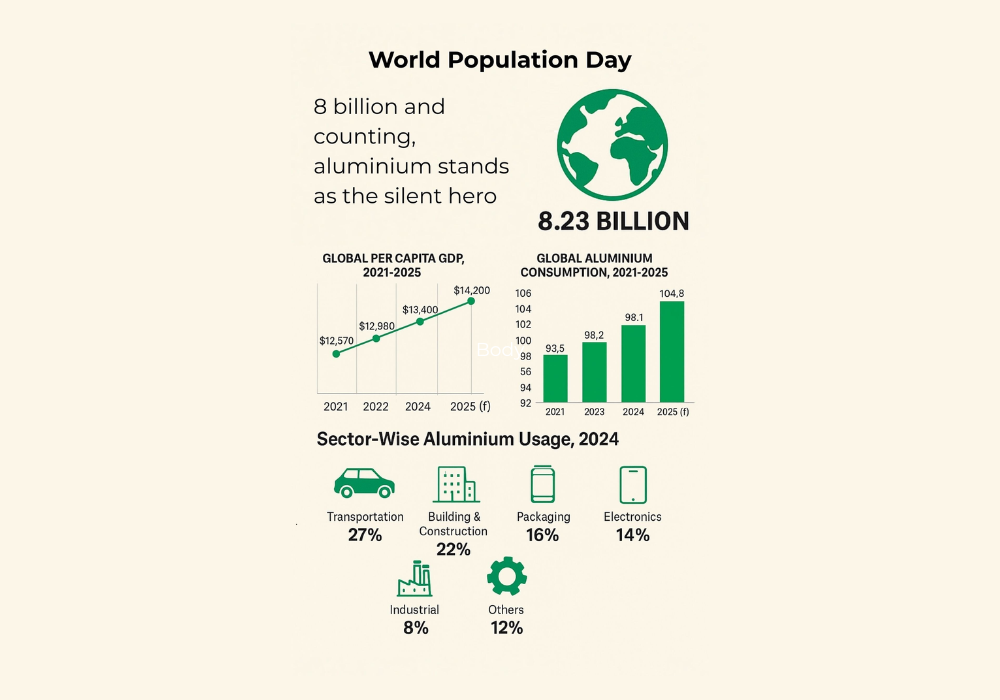

The world is filling up fast. Every tick of the clock brings more people, more cities, more cars, more gadgets, and with it, a mountain of "more" that the planet somehow has to sustain. By 2050, we're looking at nearly 10 billion people all wanting homes to live in, food on their plates, devices in their hands, and clean energy to power it all.

On the occasion of World Population Day, team AL Circle brings you this special feature, spotlighting how one unassuming metal aluminium, is quietly stepping up to meet the demands of a world that just won't stop growing. In the age of "more," aluminium might just be the material of the century.
Currently, the world population stands at 8.23 billion. So, who or rather what, is going to help carry this load? Enter aluminium, the silent, shiny sidekick that's quietly holding up the modern world. It's the metal that keeps our skyscrapers standing, our EVs moving, our soda cans chilling, and our smartphones buzzing. Light, strong, endlessly recyclable aluminium is everywhere, yet hardly ever in the spotlight.
Aluminium – the silent hero
World GDP and aluminium consumption are closely interconnected, as economic growth drives demand for aluminium across various sectors. As global GDP rises, countries experience increased industrial activity, urbanisation, and consumer spending, all of which fuel the need for aluminium. This versatile metal is essential in industries such as construction, transportation, packaging, and electronics, which tend to expand alongside economic development.
The global per capita GDP has shown steady growth from 2021 to the projected figures for 2025:
This upward trend reflects consistent economic expansion, which aligns with the simultaneous rise in global aluminium consumption during the same period. This represents an approximate 13 per cent increase in global per capita GDP from 2021 to 2025.
Parallel to this economic growth, global aluminium consumption has also witnessed a significant upward trajectory:
This is a nearly 11 million tonne increase in just five years, highlighting aluminium's critical role in meeting the world's growing needs.
Higher GDP levels often correlate with greater infrastructure investment, more vehicles on the road, higher production of consumer goods, and growth in renewable energy projects, all of which rely on aluminium's lightweight, durable, and recyclable properties. Overall, aluminium consumption serves as both a driver and a reflection of global economic health. In 2024, the sector-wise aluminium usage has also shown significant growth with –
Growth comes with a cost
However there is a flip side also as growth in any industry be it aluminium is incomplete without any hindrance or stop block. And in the case of aluminium, the hindrance or the flip side is soaring emissions. With more people comes more carbon unless materials and industries shift to low-carbon pathways.
And this is where a latest report by the Mission Possible Partnership (MPP) has shared a gentle reminder. A recent update from the MPP, a global coalition driving the decarbonisation of the world’s most carbon-intensive sectors paints a mixed picture. The aluminium industry, however, is showing unexpected leadership. So far, 25 per cent of its 2030 decarbonisation target is either already up and running or has reached the crucial final investment decision stage. The vision? To roll out 165 low-carbon aluminium refineries and smelters across the globe, setting the pace for cleaner industrial production in the race against time.
As aluminium consumption climbs alongside global GDP, the industry’s shift towards greener production will play a crucial role not only in sustaining a growing population but also in safeguarding the planet for future generations. In this dual journey of growth and green transition, aluminium stands as both a silent hero and a catalyst for change.
As we mark World Population Day, it is a moment to reflect not only on the challenges of a rapidly growing global population but also on the innovative solutions that can help sustain it. Aluminium stands at the heart of this transformation, enabling the development of resilient infrastructure, green mobility, sustainable packaging, and clean energy essentials for a world that is expanding both in numbers and aspirations. In the face of rising demand for resources, aluminium's unique qualities of lightness, durability, and endless recyclability make it a critical ally in building a future that balances growth with sustainability.
On this World Population Day, aluminium reminds us that the materials we choose today will shape the world we leave for tomorrow.
Responses








